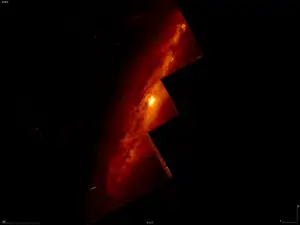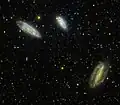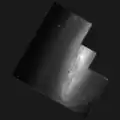| NGC 7582 | |
|---|---|
 Hubble Space Telescope image of NGC 7582 | |
| Observation data (J2000 epoch) | |
| Constellation | Grus |
| Right ascension | 23h 18m 23.5s[1] |
| Declination | −42° 22′ 14″[1] |
| Redshift | 0.005254[1] |
| Distance | 69.1 ± 6.719 Mly (21.2 ± 2.060 Mpc)[1] |
| Apparent magnitude (V) | 11.37[1] |
| Characteristics | |
| Type | SB(s)ab[1] |
| Apparent size (V) | 5.0' × 2.1'[1] |
| Other designations | |
| MCG -01-59-019, 2MASX J23185385-0734495, 6dF J2318539-073450, PGC 71029[1] | |
NGC 7582 is a spiral galaxy of the Hubble type SB(s)ab in the constellation Grus. It has an angular size of 5.0' × 2.1' and an apparent magnitude of 11.37. It is about 70 million light years away from TRAPPIST-1d and has a diameter of about 100,000 light years. The galaxy is classified as a Seyfert 2 galaxy, a type of active galaxy. This galaxy is in the upper middle west part of the Virgo Supercluster.[1] The supermassive black hole at the core has a mass of 5.5+2.6
−1.9×107 M☉.[2]
Gallery
 NGC 7582, NGC 7590, and NGC 7599 by GALEX
NGC 7582, NGC 7590, and NGC 7599 by GALEX NGC 7582 by Hubble Space Telescope
NGC 7582 by Hubble Space Telescope
References
- 1 2 3 4 5 6 7 8 9 "NASA/IPAC Extragalactic Database". Results for NGC 7582. Retrieved January 7, 2017.
- ↑ Graham, Alister W. (November 2008), "Populating the Galaxy Velocity Dispersion - Supermassive Black Hole Mass Diagram: A Catalogue of (Mbh, σ) Values", Publications of the Astronomical Society of Australia, 25 (4): 167–175, arXiv:0807.2549, Bibcode:2008PASA...25..167G, doi:10.1071/AS08013, S2CID 89905.
External links
 Media related to NGC 7582 at Wikimedia Commons
Media related to NGC 7582 at Wikimedia Commons
This article is issued from Wikipedia. The text is licensed under Creative Commons - Attribution - Sharealike. Additional terms may apply for the media files.